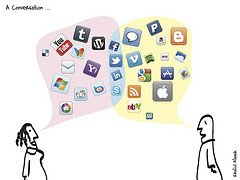 My job as a web strategist in Student Affairs at Metropolitan State University (St. Paul, Minn.) didn’t originally include social media in its description, but it was an area that our marketing department had not yet pursued (and didn’t seem too interested in pursuing it, either). DigitalTrends tells us that 2/3 of prospects use social media to research higher education institutions; from an admissions standpoint, we couldn’t afford NOT to have a presence.
My job as a web strategist in Student Affairs at Metropolitan State University (St. Paul, Minn.) didn’t originally include social media in its description, but it was an area that our marketing department had not yet pursued (and didn’t seem too interested in pursuing it, either). DigitalTrends tells us that 2/3 of prospects use social media to research higher education institutions; from an admissions standpoint, we couldn’t afford NOT to have a presence.
There were no guidelines around usage or anything established at our institution, so we approached it like a land grab in the Wild West: stake out a claim and make it work for you.
We started out with what seemed like a golden trifecta: Facebook, Twitter, and Tumblr. Our research told us our strongest following was on Facebook and Twitter, so after we were ready to roll, we launched an awareness campaign that focused mostly on drawing students to the Facebook and Twitter, and we used Tumblr to host content.
What we expected were followers, slowly but surely, drawn to our relevant and timely messages. In a few weeks, what we got was 20 percent of the student body following us, and many students posted stories to our page. Like, really sweet, tear-up-over-all-the-feelings-types of stories:
To list a few. So we’re like, YES! This is amazing and moving and validates why we work here. It’s the type of marketing that money can’t buy (well, earnest marketing, not the boozy, “Mad Men” kind of marketing).
But we wanted to use this momentum and parlay it into something that could connect our students across our campuses (Metro State has 4 campuses across the Minnesota-Twin Cities metropolitan area, as well as a lot of online offerings) and across their life experiences (students range in age from 17-72, and on average transfer in 30+ credits).
Additionally, we asked, how do we expand the conversation across other mediums? And what other mediums make sense for us to consider? To answer these questions, we turned to other methodologies and research devices to inform these decisions, like the Gartner Hype Cycle (promise of an emerging technology within the context of industry and individual appetite for risk) and the Pew Research Center’s State of Social Media Users report.
Armed with our research, a little creativity and some legal jargon to slap on contest materials, we designed a simple social media contest:
What’s Your Favorite Nook On Campus?
Basically, this resulted in students uploading pictures of their favorite spots around campus using Twitter, Instagram, Facebook, Pinterest, etc. We asked them to use the hashtag #metrostateu. Any entry submitted properly was collated using a third party app, and folks could then vote on their favorite pictures. The three pictures with the most ‘likes’ would each win a Barnes & Noble Nook HD+. (See what we did there?!)
We marketed the promotion like crazy through each social outlet as well as the student newspaper, announcement tools and word of mouth.
Over the course of the contest, we received more than 100 pictures. Using the picture-taker’s permission, we got a LOT of content to use and share, and visibility and buzz for Metro State went through the roof (analytically speaking). The long-term effects of the campaign helped us learn how to communicate with our users and showed us the types of content they want–and also what types of furniture or parts of campus are most popular. In short, the campaign was a success, and it can be broken down into three basic stages:
- Initiate
Listen. What are people saying or posting? Find the threads of ideas, and pull them to see where they go.Tie your goals to a larger initiative or upcoming trends to not only stay on track, but also to give the campaign a leg up to succeed and to help prove efficacy. Start with goals and/or questions. What do you want to happen? What’s your hypothesis? - Facilitate
Choose content that not only works across mediums, but is also EASY to share. By using a hashtag that was easy to remember, it was simple for students to snap a picture on their phone, tag it and upload.Promote internally as well as externally. Each campus was excited to see what spots came up as favorites, and their comments and interactions helped lend support to the initiative. - Evaluate
Two questions: What did you want to happen? And: Did it happen?
Prove it. Look for data that marries the two well. Compare Facebook, Twitter or other insights with what’s happening on your website. Throughout the campaign, I created automated reports (Metro State uses Google Analytics) that made it easy for me to compare consistent data before, throughout and after the campaign. By importing data into Microsoft Excel, it was doubly easy to create visualizations to update superiors on what was happening. And HIPPOs *love* visualizations, don’t they?
The ability to leverage user-generated content is one of biggest trends in marketing, but it can also be challenging to do without puting an actionable plan in place and developing baseline metrics. But when done strategically, the results can be inspiring and rewarding. It’s fun to see students and coworkers get excited, and enthusiasm is contagious.
Photo Credit: <a href=”http://www.flickr.com/photos/47130629@N04/5653817859/”>khalid Albaih</a> via <a href=”http://compfight.com”>Compfight</a> <a href=”http://creativecommons.org/licenses/by/2.0/”>cc</a>



